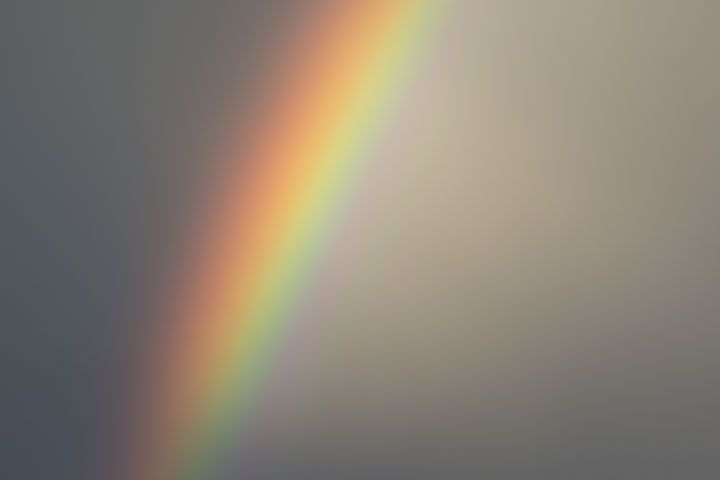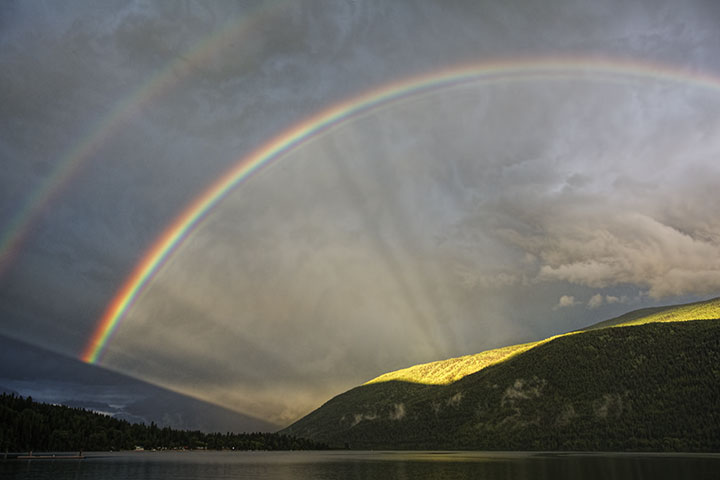I found yesterday’s rainbow picture to be so delicious that it had to be savoured alone: it was the nicest shot I have managed of a semicircular bow replete with its reflection in the calm waters of the Lake.
Yet, during the half-hour I watched the rainbow, features shifted as the shower moved along the Lake and the lighting changed. There was much to see.
The colours of the rainbow blend continuously one into another. The crayon-box claim that there are seven colours in the bow is silly: the standard mnemonic, Roy G. Biv (red, orange, yellow, green, indigo, violet) merely gives the order of colours that may or may not be seen, but which are certainly not discrete. Other striking features seen here are that red is on the outside of the curve (not on the inside as much commercial art suggests), and it is brighter inside the bow than outside.
There is a much to discover in the next scene: bright central disk, anticrepuscular rays forming radii to the bow, a larger secondary bow with red on the inside, faint supernumerary bows on the inside of the primary bow, and colours improving as the bow becomes nearly vertical. A particular feature might not be evident in every rainbow, but as one watches the bow evolve, each is worth descrying. The fact that these characteristics are well understood only enhances the grandeur of the event.

Alistair, thank you for these great shots (today and yesterday). Think of the order of magnitude difference between the individual drop (1 mm, say) and the diameter of the phenomenon (I guess at least 10 km, but you must have a better estimate).
Regards, Michael H.
Michael, this is a tricky comparison to make because while a raindrop has a linear dimension that can be measured with a ruler, a rainbow does not. Rather it has an angular size. As one looks at a spot on a rainbow, every raindrop between the eye and infinity contributes to the light seen. So, you cannot construct a dimensionless ratio. That being said, it is correct that each raindrop has a position in space, so one can say that for a shallow shower that is, say, a kilometre away, that the drops that contribute to opposite sides of the bow be about 1.4 kilometres apart (the cord distance). Of course, if the rainbow were in a garden sprinkler a metre away, the drops would be about 1.4 metres apart.
Vienna, 23 June 2014
Alistair, thank you, this was exactly what I tried to find out: The linear distance of the drops that generate the angular phenomenon. Given the mountains in the background I thought it is considerably larger than 1 km but this must be an overestimate. Evidently, one cannot tell the distance from eye to drop by looking just along the line that connects the two.
No matter, thanks again for the impressive shots, Michael. H.
Michael, I am afraid I have inadvertently mislead you while making a somewhat different point. The distance to the peninsula at the bottom left of the picture is two kilometres. The shower probably extends from there for another two kilometres.
I’ve never seen a rainbow that ends (or begins) so abruptly.
Lorna, the bow ends abruptly on the left because the sunlight is blocked there by a mountain that is behind us. You can also see that the lower slopes of another mountain in the bottom middle and right is in the same shadow. So, no sunlight, no rainbow. The other dark rays forming radials to the bow are shadows cast by clouds that are also behind the photographer.